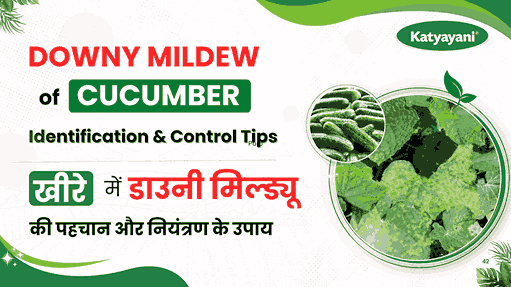Downy mildew is a common but serious fungal-like disease affecting cucumber crops worldwide. Caused by the pathogen Pseudoperonospora cubensis, this disease can significantly reduce yield and quality. In this blog, we’ll walk you through how to identify downy mildew in cucumbers and share top solutions to effectively control it.
Understanding Downy Mildew on Cucumbers
Downy mildew spreads quickly in humid conditions, and recognizing the symptoms early can help prevent major crop losses. Here’s how to spot it:
Common Symptoms of Downy Mildew on Cucumbers:
- Yellowing Leaves: The first sign of infection is yellowing leaves, often starting at the margins and spreading throughout the plant.
- Cottony Growth: A grayish-white, cotton-like growth forms on the underside of infected leaves, especially during humid weather conditions.
- Leaf Drop: Severe infection can lead to premature defoliation, reducing the plant’s ability to produce fruit and increasing the risk of sunscald.
- Fruit Infection: In rare cases, cucumber fruits may also show water-soaked, sunken lesions, signaling infection.
Managing Downy Mildew on Cucumber Plants
Downy mildew can severely impact cucumber plants, leading to poor yields and reduced fruit quality. Early intervention with the right treatment options can protect your crops and restore plant health. Here’s how to manage the disease effectively:
Best Bio & Organic Treatments for Cucumber Downy Mildew:
All in One Organic Fungicide
- Dosage: 1.5-2 gms per liter of water
- Type: Organic fungicide
- Benefits: A multi-purpose organic solution to combat downy mildew and other common plant diseases.
- Dosage: 1.5-2 liters per acre
- Type: Bio fungicide
- Benefits: A biological control agent that inhibits the spread of downy mildew by boosting plant immunity.
- Dosage: 3 grams per liter
- Type: Bio fungicide
- Benefits: A natural fungus that prevents downy mildew while promoting plant health.
Striker (Pseudomonas Fluorescens)
- Dosage: 4 ml per liter of water
- Type: Bio fungicide
- Benefits: A highly effective biological treatment that targets fungal pathogens like downy mildew.
Chemical Control Methods for Cucumber Downy Mildew:
For more severe infestations, chemical fungicides can provide fast-acting results. Here are some top-rated options:
- Dosage: 350-400 grams per acre
- Type: Chemical fungicide
- Benefits: Copper-based fungicide that effectively controls fungal growth and prevents downy mildew.
- Dosage: 350-400 grams per acre
- Type: Chemical fungicide
- Benefits: A broad-spectrum fungicide that offers strong protection against downy mildew.
TEBUSUL (Tebuconazole 10% + Sulphur 65% WG)
- Dosage: 400 grams per acre
- Type: Chemical fungicide
- Benefits: Combines systemic action and sulfur for effective disease control.
SAMARTHA (Carbendazim 12% + Mancozeb 63% WP)
- Dosage: 350-400 grams per acre
- Type: Chemical fungicide
- Benefits: A dual-action product that targets fungal diseases in cucumbers and other crops.
Prevention Tips to Keep Downy Mildew Away:
- Improve Airflow: Proper plant spacing and pruning help reduce humidity around plants, making it harder for the disease to spread.
- Avoid Overhead Watering: Use drip irrigation to prevent water from splashing on leaves, which can spread the disease.
- Use Resistant Varieties: Plant cucumber varieties that are resistant to downy mildew, reducing the chances of infection.
- Apply Preventive Fungicides: Regular application of fungicides can prevent the onset of downy mildew.
- Remove Infected Plant Parts: Prune any affected leaves and dispose of them carefully to limit further infection.
Frequently Asked Questions (FAQs)
Q1. What is downy mildew, and how does it affect cucumbers?
A. Downy mildew is caused by the fungus-like pathogen Pseudoperonospora cubensis. It affects cucumbers by causing yellowing of leaves, defoliation, and reduced fruit production.
Q2. How is downy mildew transmitted?
A. The disease spreads through wind-borne spores, water splashes, and human contact, making it highly contagious in humid conditions.
Q3. What fungicides work best for cucumber downy mildew?
A. Copper-based products, like COC 50, and organic fungicides, like Tyson (Trichoderma Viride), are effective in controlling downy mildew.
Q4. How often should I apply fungicide for downy mildew?
A. Apply fungicides every 7-14 days, depending on the severity of the infestation. Always follow product instructions for best results.
Q5. Can downy mildew cause permanent damage to cucumbers?
A. Yes, if left untreated, downy mildew can lead to significant damage, including reduced yields and poor fruit quality. Early intervention is key to preventing permanent damage.


